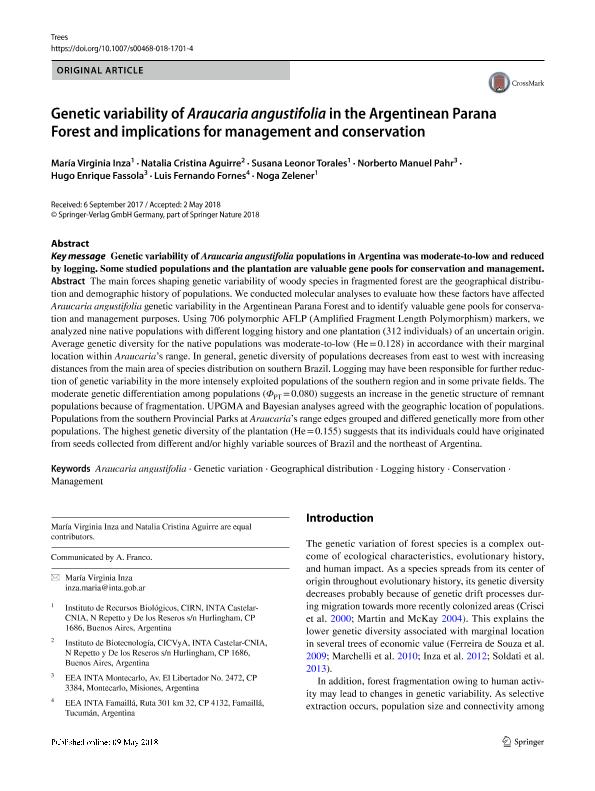Mostrar el registro sencillo del ítem
dc.contributor.author
Inza, María Virginia

dc.contributor.author
Aguirre, Natalia Cristina

dc.contributor.author
Torales, Susana

dc.contributor.author
Pahr, Norberto Manuel

dc.contributor.author
Fassola, Hugo Enrique

dc.contributor.author
Fornes, Luis Fernando

dc.contributor.author
Zelener, Noga

dc.date.available
2020-03-16T19:47:17Z
dc.date.issued
2018-08
dc.identifier.citation
Inza, María Virginia; Aguirre, Natalia Cristina; Torales, Susana; Pahr, Norberto Manuel; Fassola, Hugo Enrique; et al.; Genetic variability of Araucaria angustifolia in the Argentinean Parana Forest and implications for management and conservation; Springer; Trees; 32; 4; 8-2018; 1135-1146
dc.identifier.issn
0931-1890
dc.identifier.uri
http://hdl.handle.net/11336/99678
dc.description.abstract
The main forces shaping genetic variability of woody species in fragmented forest are the geographical distribution and demographic history of populations. We conducted molecular analyses to evaluate how these factors have affected Araucaria angustifolia genetic variability in the Argentinean Parana Forest and to identify valuable gene pools for conservation and management purposes. Using 706 polymorphic AFLP (Amplified Fragment Length Polymorphism) markers, we analyzed nine native populations with different logging history and one plantation (312 individuals) of an uncertain origin. Average genetic diversity for the native populations was moderate-to-low (He = 0.128) in accordance with their marginal location within Araucaria’s range. In general, genetic diversity of populations decreases from east to west with increasing distances from the main area of species distribution on southern Brazil. Logging may have been responsible for further reduction of genetic variability in the more intensely exploited populations of the southern region and in some private fields. The moderate genetic differentiation among populations (ΦPT = 0.080) suggests an increase in the genetic structure of remnant populations because of fragmentation. UPGMA and Bayesian analyses agreed with the geographic location of populations. Populations from the southern Provincial Parks at Araucaria’s range edges grouped and differed genetically more from other populations. The highest genetic diversity of the plantation (He = 0.155) suggests that its individuals could have originated from seeds collected from different and/or highly variable sources of Brazil and the northeast of Argentina.
dc.format
application/pdf
dc.language.iso
eng
dc.publisher
Springer

dc.rights
info:eu-repo/semantics/openAccess
dc.rights.uri
https://creativecommons.org/licenses/by-nc-sa/2.5/ar/
dc.subject
ARAUCARIA ANGUSTIFOLIA
dc.subject
CONSERVATION
dc.subject
GENETIC VARIATION
dc.subject
GEOGRAPHICAL DISTRIBUTION
dc.subject
LOGGING HISTORY
dc.subject
MANAGEMENT
dc.subject.classification
Conservación de la Biodiversidad

dc.subject.classification
Ciencias Biológicas

dc.subject.classification
CIENCIAS NATURALES Y EXACTAS

dc.subject.classification
Bioquímica y Biología Molecular

dc.subject.classification
Ciencias Biológicas

dc.subject.classification
CIENCIAS NATURALES Y EXACTAS

dc.title
Genetic variability of Araucaria angustifolia in the Argentinean Parana Forest and implications for management and conservation
dc.type
info:eu-repo/semantics/article
dc.type
info:ar-repo/semantics/artículo
dc.type
info:eu-repo/semantics/publishedVersion
dc.date.updated
2020-03-11T13:03:55Z
dc.journal.volume
32
dc.journal.number
4
dc.journal.pagination
1135-1146
dc.journal.pais
Alemania

dc.journal.ciudad
Berlín
dc.description.fil
Fil: Inza, María Virginia. Instituto Nacional de Tecnología Agropecuaria. Centro de Investigación de Recursos Naturales. Instituto de Recursos Biológicos; Argentina
dc.description.fil
Fil: Aguirre, Natalia Cristina. Instituto Nacional de Tecnología Agropecuaria. Centro de Investigación en Ciencias Veterinarias y Agronómicas. Instituto de Biotecnología; Argentina. Consejo Nacional de Investigaciones Científicas y Técnicas; Argentina
dc.description.fil
Fil: Torales, Susana. Instituto Nacional de Tecnología Agropecuaria. Centro de Investigación de Recursos Naturales. Instituto de Recursos Biológicos; Argentina
dc.description.fil
Fil: Pahr, Norberto Manuel. Instituto Nacional de Tecnología Agropecuaria. Centro Regional Misiones. Estación Experimental Agropecuaria Montecarlo; Argentina
dc.description.fil
Fil: Fassola, Hugo Enrique. Instituto Nacional de Tecnología Agropecuaria. Centro Regional Misiones. Estación Experimental Agropecuaria Montecarlo; Argentina
dc.description.fil
Fil: Fornes, Luis Fernando. Instituto Nacional de Tecnología Agropecuaria. Centro Regional Tucuman-Santiago del Estero. Estación Experimental Agropecuaria Famaillá; Argentina
dc.description.fil
Fil: Zelener, Noga. Instituto Nacional de Tecnología Agropecuaria. Centro de Investigación de Recursos Naturales. Instituto de Recursos Biológicos; Argentina
dc.journal.title
Trees

dc.relation.alternativeid
info:eu-repo/semantics/altIdentifier/url/https://link.springer.com/article/10.1007/s00468-018-1701-4
dc.relation.alternativeid
info:eu-repo/semantics/altIdentifier/doi/http://dx.doi.org/10.1007/s00468-018-1701-4
Archivos asociados
